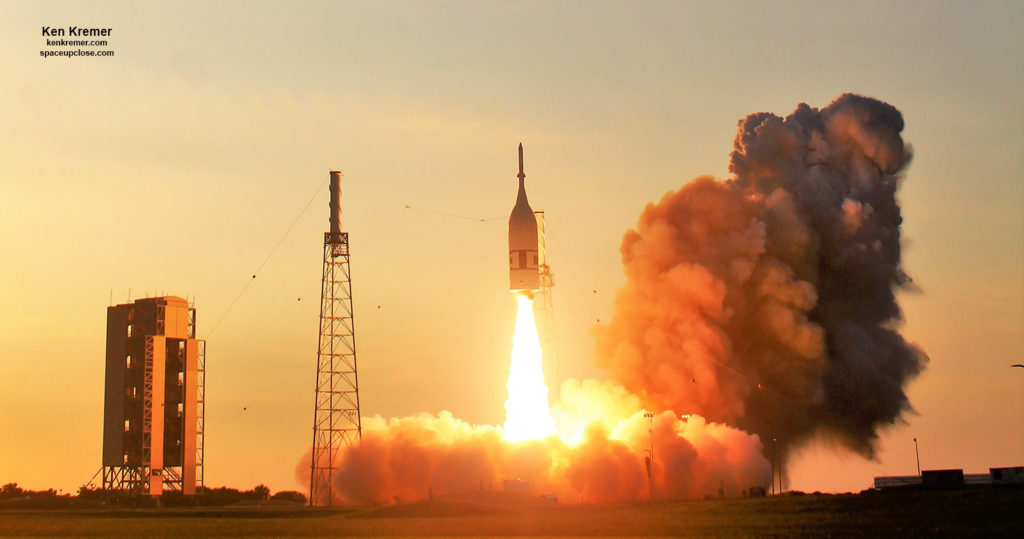 |
|
NASA’s Ascent Abort-2 mission successfully launched at 7 a.m. EDT July 2, 2019 from
Space Launch Complex 46 at Cape Canaveral Air Force Station in Florida on a
critical test of the Launch Abort System (LAS) with a test version of the Orion
crew module in this remote camera view. Credit: Ken Kremer/kenkremer.com/spaceupclose.com
|
Ken Kremer — SpaceUpClose.com & RocketSTEM – 2 July 2019
KENNEDY SPACE CENTER, FL – NASA successfully completed an exhilarating, action-packed andcritical full stress test of the Orion deep space crew capsules abort system Tuesday morning July 2 thereby paving the path for human Artemis missions to the Moon launching from the FloridaSpace Coast.
The Ascent Abort-2 mission is all about saving astronauts lives in case of a rocket emergency and launch failure using the fully functional Launch Abort System (LAS) tower bolted atop the Orion capsule.
“NASA successfully demonstrated Tuesday the Orion spacecraft’s launch abort system can outrun a speeding rocket and pull astronauts to safety during an emergency during launch. The test is another milestone in the agency’s preparation for Artemis missions to the Moon that will lead to astronaut missions to Mars,” said NASA officials.
Liftoff of the AA2 mission took place right on time at 7 a.m. EDT July 2 from Launch Complex 46 on Cape Canaveral Air Force Station at the opening of the 4 hour long launch window atop a retired and refurbished Peacekeeper ICBM 1st stage nuclear missile motor.
The LAS is equipped with three different types of motors to pull the capsule away, flip it around and jettison the tower to deploy it and everything appeared to function as designed.
The sunrise launch was spectacularly beautiful under sunny conditions that were about as good as one could have hoped for with a clear view of the entire test sequence which as short as intended and lasted approximately 3 minutes.
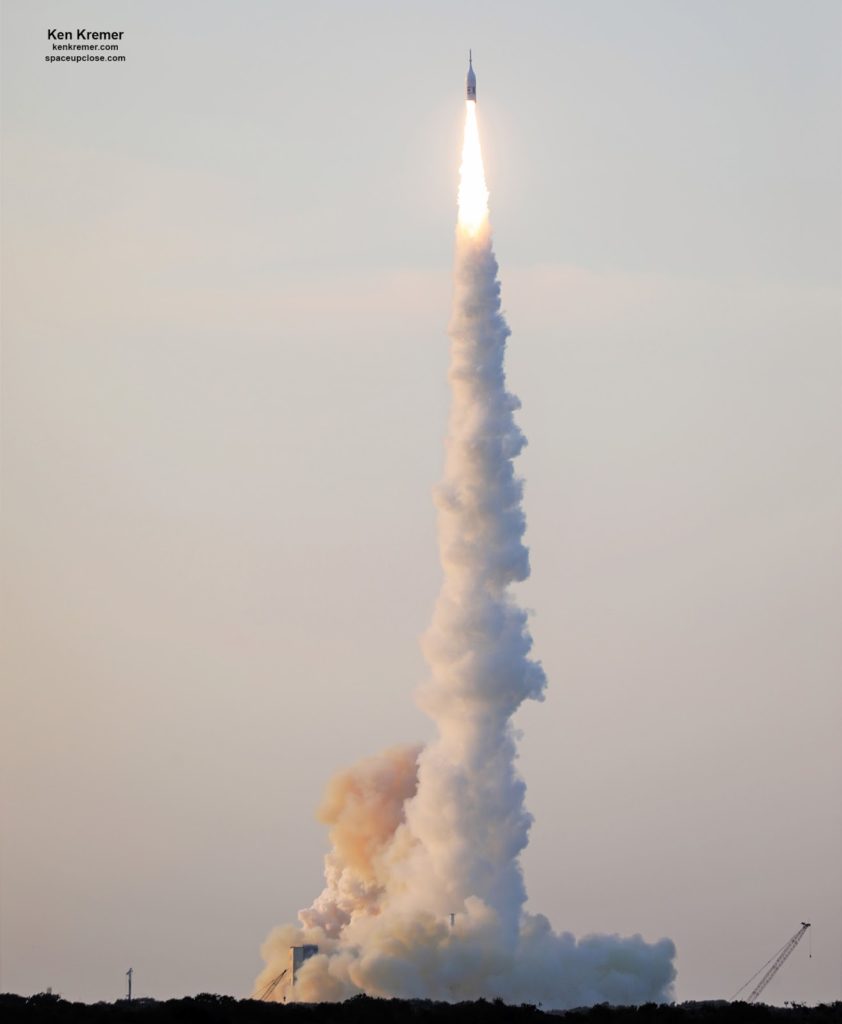 |
|
NASA’s Ascent Abort-2 mission successfully launched at 7 a.m. EDT July 2, 2019 from
Space Launch Complex 46 at Cape Canaveral Air Force Station in Florida on a
critical test of the Launch Abort System (LAS) with a test version of the Orion
crew module. Credit: Ken Kremer/kenkremer.com/spaceupclose.com
|
“Launching into space is one of the most difficult and dangerous parts of going to the Moon,” said Mark Kirasich, Orion program manager at Johnson Space Center in Houston.
“This test mimicked some of the most challenging conditions Orion will ever face should an emergency develop during the ascent phase of flight.Today, the team demonstrated our abort capabilities under these demanding conditions and put us one huge step closer to the first Artemis flight carrying people to the Moon,” at the post launch media briefing at NASA’s Kennedy Space Center press site.
“It was really special for the program, and really a big step forward for us.”
“We couldn’t have asked for a better flight, better mission, better performance,” said Don Reed, head of the Orion flight test management office. “That about sums it up.”
The short three minute long Ascent Abort-2 flight test of the launch abort system for NASA’s Orion spacecraft will have a lasting impact on NASA’s plans to send astronauts back to the Moon on Artemis missions first in orbit and then to the lunar surface by 2024 and eventually to Mars in the
2030s.Enjoy my photos of the AA2 test flight on site at the Kennedy Space Center and Cape Canaveral Air Force Station.
Check back as the gallery grows.
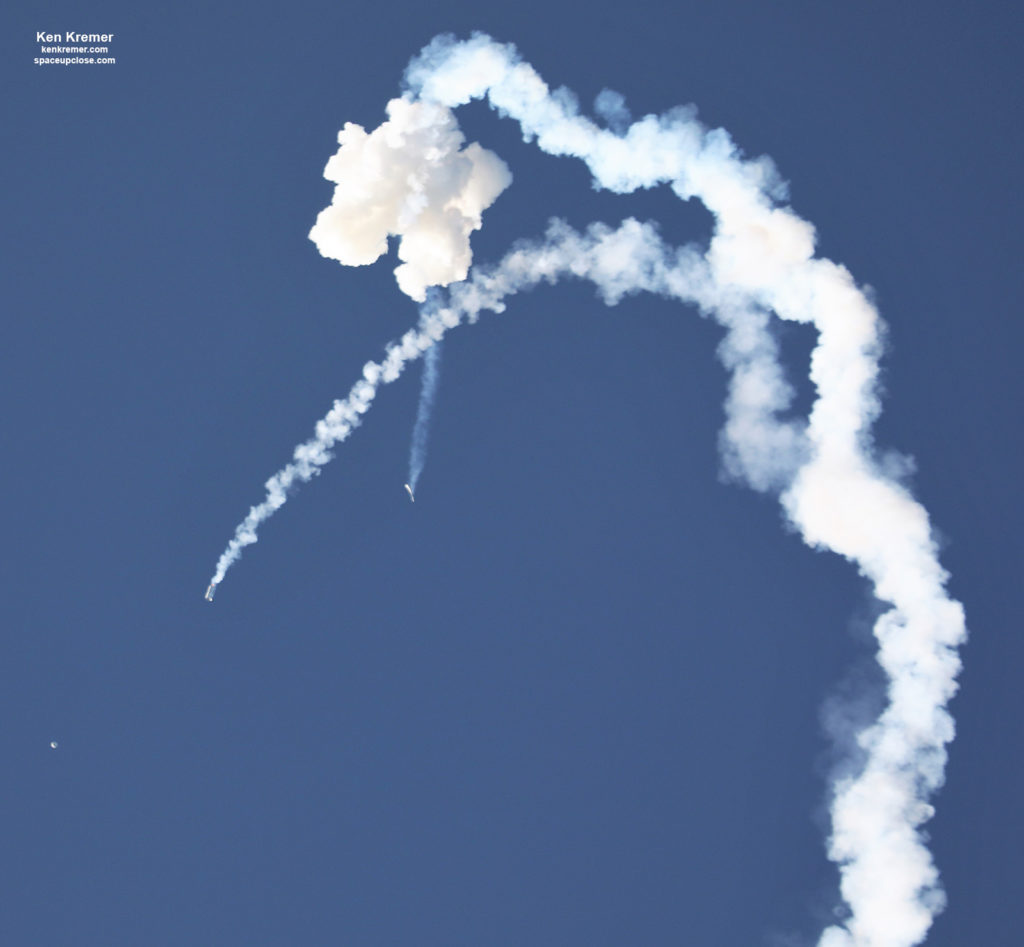 |
|
3 major components of NASA Orion Ascent Abort-2 test flight
successfully separate and fall back to Earth after liftoff at 7 a.m. EDT, July
2, 2019 – mock Orion crew capsule, Peacekeeper 1st stage booster and Launch
Abort System (LAS) – to demonstrate that launch abort escape system will save
astronauts lives in case of a catastrophic rocket failure. Credit: Ken Kremer/kenkremer.com/spaceupclose.com
|
The launch vehicle stack stands 93 feet (28 meters) tall and consists of a mock Orion capsule atop a retired and modified Peacekeeper ICBM 1st stage motor certified and procured through the U.S. Air Force and built by Northrop Grumman with the Launch Abort System (LAS) tower bolted on top and built by prime contractor Lockheed Martin with a jettison motor provided by Aerojet Rocketdyne.
The AA-2 test flight cost approximately $256 million.
AA-2 is the last Orion test flight prior to the uncrewed Artemis 1 mission to the Moon and back targeted for late 2020 or 2021.
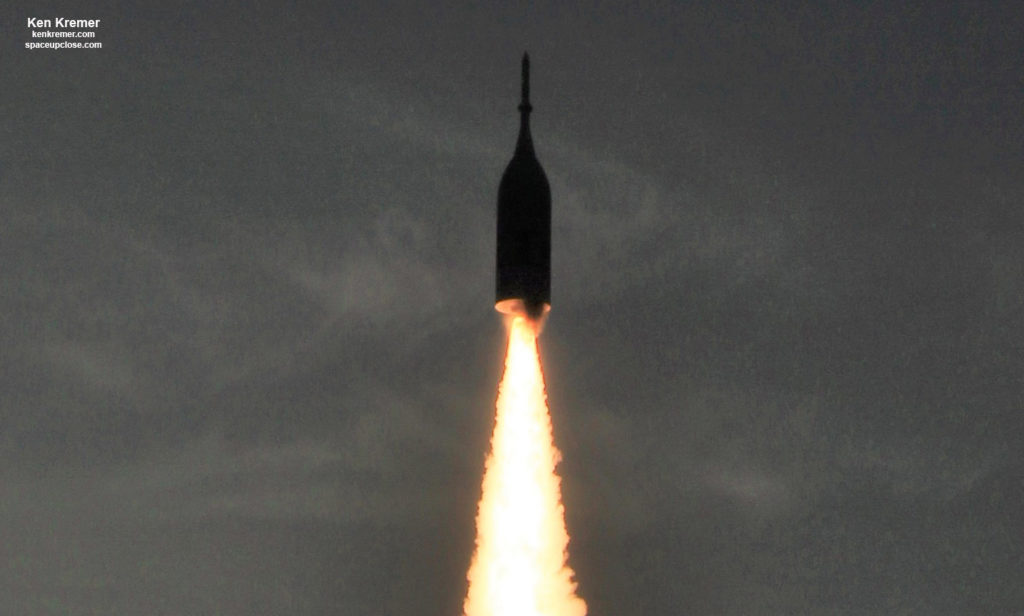 |
|
UpClose look of NASA’s Ascent Abort-2 mission successfully launched on Peacekeeper ICBM
missile at 7 a.m. EDT July 2, 2019 from Space Launch Complex 46 at Cape
Canaveral Air Force Station in Florida on a critical test of the Launch Abort
System (LAS) with a test version of the Orion crew module – in this remote
camera view. Credit: Ken Kremer/kenkremer.com/spaceupclose.com
|
The 22,000 pound Orion test spacecraft traveled to an altitude of about six miles (31,000 ft, 9800 m) powered by the 400,000 pound thrust Peacekeeper stage “at which point it experienced high-stress aerodynamic conditions expected during ascent” to simulate the conditions of maximum aerodynamic pressure or ‘Max Q’ it will experience during launch on NASA’s mammoth Space Launch System (SLS) rocket.
The abort sequence was automatically triggered at T + 50 seconds as the vehicle stack was speeding skywards at Mach 1.3. Within milliseconds, the abort motor on the LAS tower fired to pull the crew module away from the rocket as would happen during a true launch emergency to save the astronauts lives and avoid catastrophe.
Then the LAS attitude control motor flipped the capsule end-over-end to properly orient it, and then the jettison motor fired, releasing the crew module for splashdown in the Atlantic Ocean some 7 miles or so off shore three minutes later.
See our Space UpClose photos documenting the entire action-packed sequence.
We could see the Peacekeeper stage drop away as the LAS fired to pull the Orion upwards and away a safe distance from the booster some 300 MPH faster using the 400,000 pound thrust from the reverse flow abort motor.
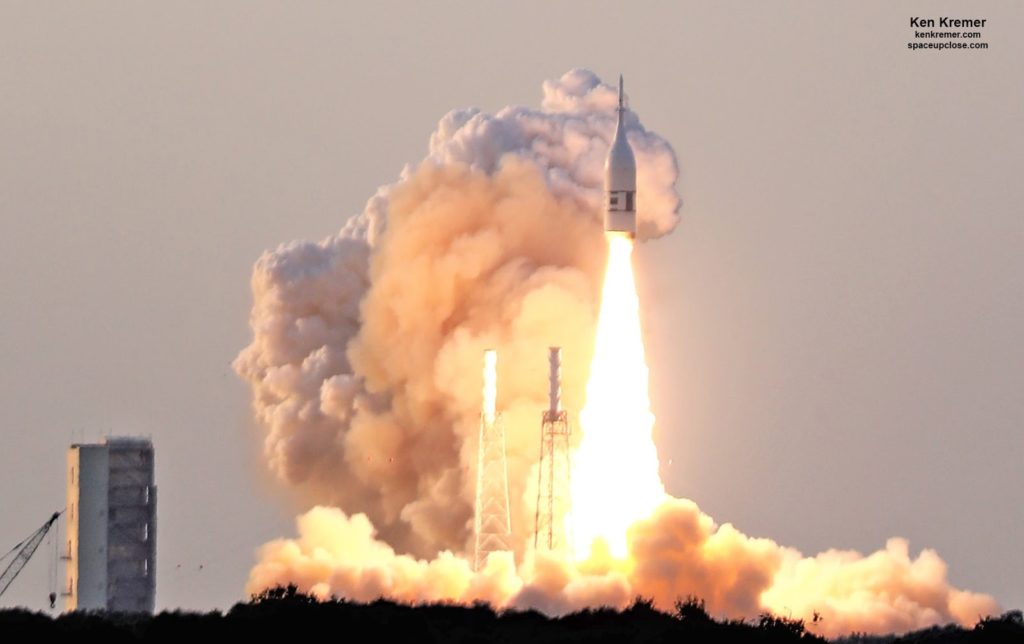 |
|
NASA’s
Ascent Abort-2 mission successfully launched at 7 a.m. EDT July 2, 2019 from
Space Launch Complex 46 at Cape Canaveral Air Force Station in Florida on a
critical test of the Launch Abort System (LAS) with a test version of the Orion
crew module. Credit: Ken Kremer/kenkremer.com/spaceupclose.com
|
The Peacekeeper stage had to be weighted down with well over 100,000 pounds of ballast to slow its acceleration and achieve the proper speed at the desired altitude for the AA-2 test.
“We actually had to add over 100,000 pounds (45 metric tons) of ballast to it just to slow it down, because it’s pretty sporty,” said Jenny Devolites, NASA’s test director for Tuesday’s flight.
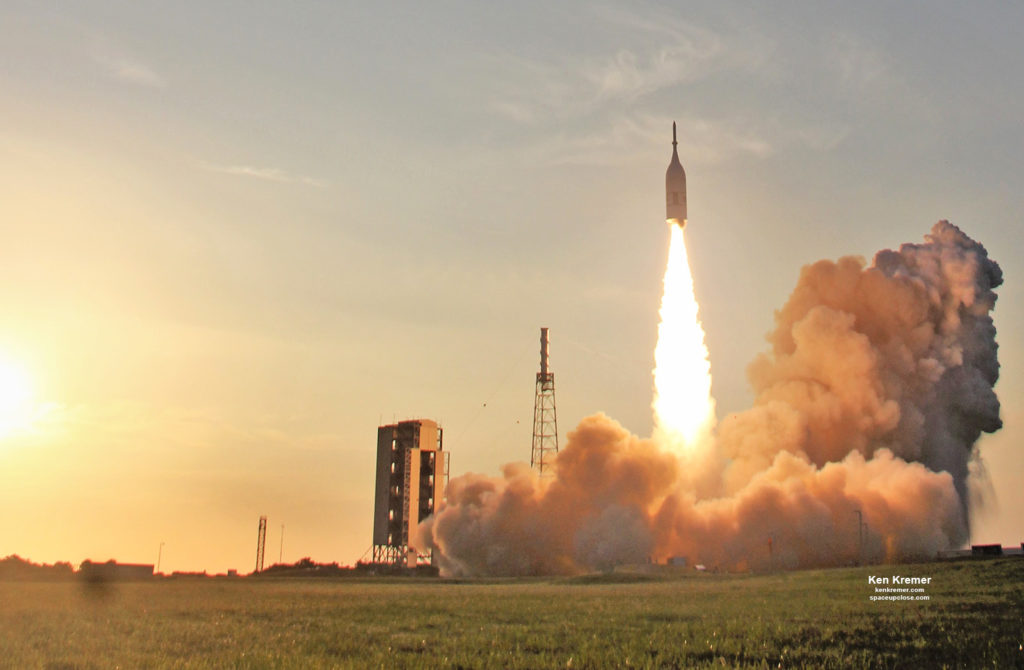 |
|
NASA’s
Ascent Abort-2 mission successfully launched at 7 a.m. EDT July 2, 2019 from
Space Launch Complex 46 at Cape Canaveral Air Force Station in Florida on a
critical test of the Launch Abort System (LAS) with a test version of the Orion
crew module in this remote camera view. Credit: Ken Kremer/kenkremer.com/spaceupclose.com
|
 |
|
3 major components of NASA Orion Ascent Abort-2 test flight
successfully separate and fall back to Earth after liftoff at 7 a.m. EDT, July
2, 2019 – mock Orion crew capsule, Peacekeeper 1st stage booster and Launch
Abort System (LAS) – to demonstrate that launch abort escape system will save
astronauts lives in case of a catastrophic rocket failure. Credit: Ken Kremer/kenkremer.com/spaceupclose.com
|
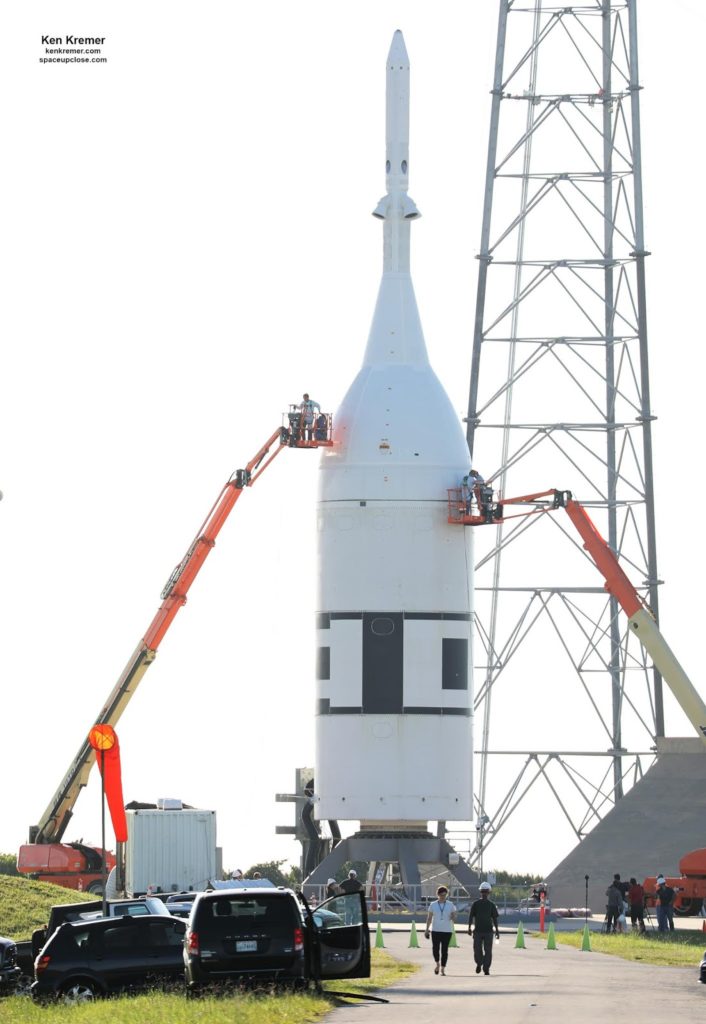 |
|
Technicians
ready a test version of NASA’s Orion crew module for Ascent Abort-2 (AA-2) test
with its launch abort system attached on July 1, 2019 at Space Launch Complex
46 at Cape Canaveral Air Force Station in Florida. Success launch of the AA-2 mission
achieved July 2, 2019 and serves as a critical safety test that helps pave the
way for Artemis missions to the Moon and then Mars. Credit:
Ken Kremer/kenkremer.com/spaceupclose.com
|
The LAS abort tower-like structure consists of two parts: the fairing assembly, which is a shell composed of a lightweight composite material that protects the capsule from the heat, air flow and acoustics of the launch, ascent, and abort environments; and the launch abort tower, which includes the abort motor, attitude control motor, and jettison motor, according to a NASA description.
Meanwhile NASA is making progress on building the huge SLS rockets core stage as Space UpClose observed up close at NASA’s Michoud Assembly Facility this past week
Watch for our upcoming articles and imagery.
“We’re building the most powerful rocket in the world to send astronauts to the Moon in the Orion spacecraft for Artemis missions,” said Bill Hill, deputy associate administrator for Exploration
Systems Development at NASA Headquarters in Washington, in a statement.
“With this exploration system designed to safely carry humans farther into space than ever before, we’ll also have an equally powerful launch abort system that will pull the crew away if there is a problem with the rocket during the early portion of ascent.”
Ken was onsite at the Kennedy Space Center for live coverage of NASA’s Orion Ascent Abort-2 test launch.
Watch for Ken’s continuing onsite coverage of NASA, SpaceX, ULA, Boeing, Lockheed Martin, Northrop Grumman and more space and mission reports direct from the Kennedy Space Center, Cape Canaveral Air Force Station, Florida and Wallops Flight Facility, Virginia.
Stay tuned here for Ken’s continuing Earth and Planetary science and human spaceflight news: www.kenkremer.com –www.spaceupclose.com – twitter @ken_kremer
– email: ken at kenkremer.com
Dr. Kremer is a research scientist and journalist based in the KSC area, active in outreach and interviewed regularly on TV and radio about space topics.
………….
Ken’s photos are for sale and he is available for lectures and outreach events
Ken’s upcoming outreach events:
Jul 2: Quality Inn Kennedy Space Center, Titusville, FL, evenings. Learn more about the upcoming/recent NASA Orion Ascent-2 Abort test Falcon Heavy, NASA 2024 Moon landing
goal, SpaceX Starlink-1, SpaceX Falcon 9/CRS-17 launch to ISS, SpaceX Demo-1 launch/test failure, SpaceX Beresheet launch, NASA missions, ULA Atlas & Delta launches,
Northrop Grumman Antares, SpySats and more
Ken’s will display his photos for sale










